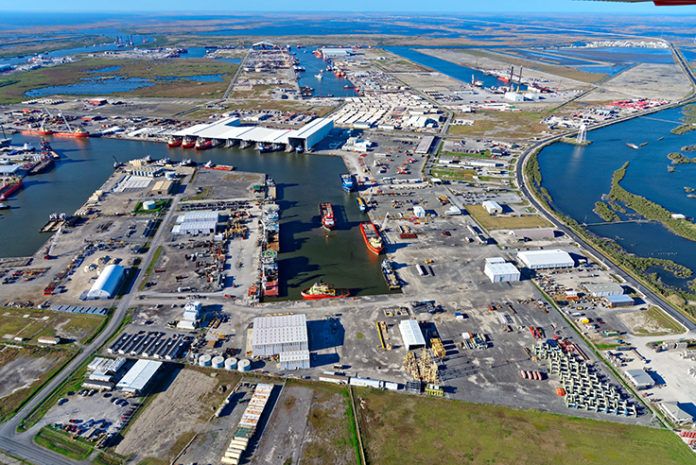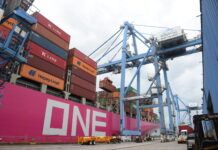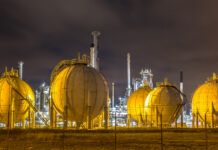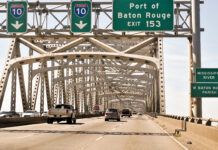The history of La. 1 in southern Lafourche Parish, in many ways, mirrors the history of economic development in the region. Built in the 1930s, the highway largely served to bring people in their Model T Fords to Grand Isle for recreation. Bayou Lafourche was not much more than a channel crossing fairly inaccessible land. Then, in 1960, the State Legislature authorized building a port in the marsh in an attempt to attract New Orleans’ lucrative banana trade.
Although the banana industry never came, the energy industry did. Over the next 50 years, Port Fourchon—Louisiana’s southernmost port—grew and developed to become the prime hub for domestic deepwater oil and gas exploration, drilling, and production in the Gulf of Mexico. Today, La. 1 supports 18% of the nation’s daily oil production and serves 90% of deepwater projects in the Gulf.
Louisiana Highway 1 runs diagonally across the state, from Port Fourchon to northwest of Shreveport. The roadway serves as the lone land route to Port Fourchon and provides the sole highway access to the Louisiana Offshore Oil Port, the nation’s only offshore oil port. As such, the two-lane highway experiences significant industry traffic. According to the Louisiana Department of Transportation and Development, the average daily traffic count for La. 1 between Port Fourchon and Golden Meadow was approximately 10,000 in 2015. Industrial vehicles account for approximately 20% of La. 1’s traffic. Yet the highway was not built to handle either this volume or this type of traffic.
“La. 1 is critical to Port Fourchon and to the business and industry in the port,” says Chett Chiasson, executive director of the Greater Lafourche Port Commission. “It’s our only road access to the port, so it’s critical to the port’s ability to service the oil and gas industry.”
At the same time, La. 1 is essential to the state’s commercial and recreational fishing industries and is vital for providing access for coastal restoration projects in Lafourche Parish and Grand Isle. La. 1 also is the only highway evacuation route for Grand Isle and Port Fourchon.
UNDER WATER
While the demands on La. 1 south of Thibodaux have risen, the road itself has been sinking. Coastal erosion, sea-level rise and ground subsidence have contributed to the highway’s vulnerability, with the road flooding even during low-level storms. The National Oceanic and Atmospheric Administration predicts that by 2027, inundation levels will result in closing a seven-mile section of the existing at-grade highway between Golden Meadow and Leeville for more than 30 days per year. In less than 40 years, this portion of La. 1 will be covered in water and impassable for more than 300 days per year.
When access to and from the port is cut off, the impact quickly reverberates nationwide. In 2011, the U.S. Department of Homeland Security concluded that a 90-day closure of the existing section of La. 1 between Golden Meadow and Leeville could result in up to a $7.8 billion loss in American gross domestic product. In 2001, Congress designated La. 1 as one of only 88 high-priority corridors nationwide because of its role as critical energy infrastructure.
Given the threats to La. 1 and the highway’s vital economic and safety role, the La. 1 Improvement Project was proposed to improve the reliability and resiliency of the La. 1 corridor from U.S. 90 to the coast. The project has involved a range of organizations, including the State of Louisiana, Lafourche Parish, the Greater Lafourche Port Commission, the Louisiana Transportation Authority, the La. 1 Coalition—a nonprofit corporation working to secure highway improvements—and the energy industry.
The $1.68 billion project consists of four phases. The $371.6 million, 11.2-mile Phase 1, consisting of a two-lane elevated highway between Leeville and Port Fourchon, was completed in December 2011.
Phase 1 was financed fairly equally through local, state and federal funds. This included $136.4 million from the Transportation Infrastructure Finance and Innovation Act, a program administered by the U.S. Department of Transportation that provides loans and standby lines of credit to projects of national or regional significance, and $60,000 from state general obligation bonds; these loans are being retired through toll revenues. La. 1 is the first project in Louisiana to use a TIFIA loan. The state also contributed nearly $13 million from the Louisiana Transportation Trust Fund and $63 million from the state general fund. Almost $125 million came from federal formula funds and earmarks. Industry has also contributed to the project, including helping to fund the state’s share of the cost of the project’s Environmental Impact Statement.
WHERE THE FUNDING ENDS

The focus today is on Phase 2 between Golden Meadow and Leeville.
“This section remains a vulnerability. Phase 2 is essential for better, more reliable access to the port,” Chiasson says.
Yet Phase 2, which would consist of an 8.3-mile, two-lane, elevated highway and cost at least $360 million, does not have the green light. The holdup? “Bottom line: it’s funding,” Chiasson says. “The right of way is bought. All the permits are in hand. It’s all about the money.”
The federal government has not made a funding commitment for Phase 2, and has rejected requests by the state for matching funds in several federal transportation grant programs. Funding applications and requests made to state government currently are under review. In a letter to the National Governors Association, Gov. John Bel Edwards listed Phase 2 as one of Louisiana’s top infrastructure priorities.
Chiasson says the project is too large and costly for existing federal and state funding capabilities.
“The struggle over the years has been that there’s no real mechanism in place to fund a project of this magnitude,” he says. “There are grant programs that provide funding for good, solid projects, but they try to fund as many projects as possible. If a grant program has $800 million, it’s not going to give one project $350 million. At best, they’ll give $15 million to $20 million for each project.”
No funding has been identified for Phase 3, a four-lane at-grade highway from U.S. 90 to Larose, or Phase 4, which involves additional lanes from Golden Meadow to Port Fourchon as well.
Additional toll revenues are unlikely to be used for Phase 2.
“We can’t place another toll on this section—tolls are already high,” says LA 1 Coalition Executive Director Henri Boulet. Tolls are set to increase 20% every five years. “If we raise tolls beyond that, it could have an adverse impact on economic development and growth for our community,” he says.
Thus, funding may have to come from multiple sources. Phase 2 has been broken into five segments, which could be built separately as funding permits.
“If you’re going to live within those parameters, it’s going to take an intelligent, creative financing package to get this project done, and that takes a lot of time,” Chiasson says.
WAITING ON THE LEGISLATURE

La. 1 is just one of a long list of highway and infrastructure improvements needed across the state. In December the Governor’s Transportation Infrastructure Task Force recommended an increased revenue stream of $700 million annually to address the state’s $13.1 billion backlog of road and bridge needs, maintenance of the system and a $16 billion list of proposed megaprojects, including Phase 2 of the La. 1 Improvement Project.
“Quite frankly, a lot of projects in Louisiana are in the same predicament because our state hasn’t funded infrastructure in years,” Boulet says. “We can barely keep up with existing highways. The state just doesn’t have the money to fund new projects.”
Still, La. 1 advocates are optimistic the state Legislature, which was in session as 10/12 Industry Report went to press, will provide more financial support.
“No one knows what will be negotiated out at the end of the legislative session,” Boulet says. “We’re hoping our state is in a better position and there will be funding available for infrastructure. We’re hopeful the project can move forward in the next few months.”
In the buildup to the legislative session, Edwards said the state must consider a gas tax hike to address its infrastructure needs. By 2019, the governor said, the state won’t be able to afford to meet its match to draw down federal transportation funding without raising Louisiana’s gas tax, which he noted has remained at 16 cents per gallon for three decades.
At the federal level, the situation is not much better. In its 2017 infrastructure report card, the American Society of Civil Engineers gave the nation a D+. ASCE blames decades of underinvestment for leading to the country’s deteriorating infrastructure.
Although President Donald Trump has stated that investing in infrastructure will be an administration priority, nothing has been proposed.
“None of us knows quite yet what the Trump administration is going to come up with and how they’re going to fund it,” Boulet adds. “A lot is riding on what comes out of the state legislative session and what comes out of Congress.”
CHIPPING AWAY
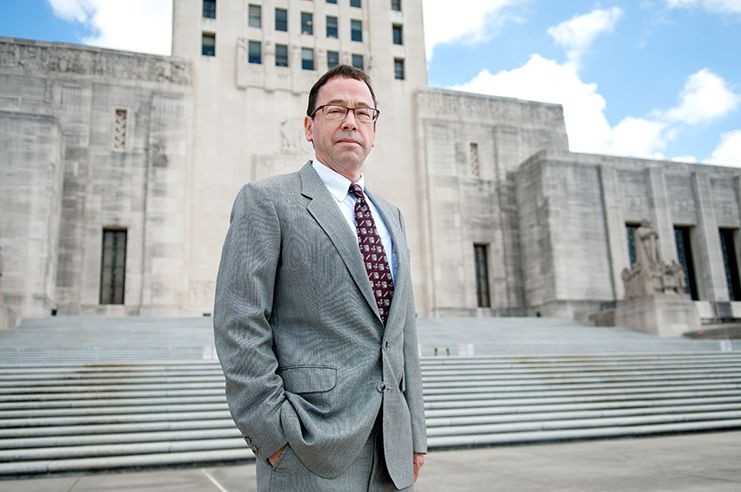
executive director,
La. 1 Coalition
Other potential funding sources include the U.S. DOT’s FASTLANE grants, which provide dedicated, discretionary funding for projects addressing critical freight issues facing U.S. highways and bridges. Funding from the Gulf of Mexico Energy Security Act is also a possibility. While the majority of GOMESA funding will go toward coastal restoration and protection, state law allows up to 10% to be used on “infrastructure directly impacted by coastal wetland loss.” In 2015, a controversial proposal to use RESTORE Act funding for the La. 1 Improvement Project was shelved after coastal community organizations, including the La. 1 Coalition and several conservation organizations, agreed to pursue GOMESA funding instead.
Both Boulet and Chiasson are confident the project will be funded and built, though perhaps not all at once as preferred.
“We’ll continue to be persistent with all levels of government to get this project done,” Chiasson says. “We’re confident that we’ll see some small pots of money that we can tap into in the next year or two to get the project moving. We’ll plug along and chip away, and maybe start with a smaller phase. We have a plan to build in timely and affordable sections if we can’t get a bigger finance package done.”
La. 1 remains a weak link in the region’s infrastructure. This was illustrated in 2012, when Hurricane Isaac resulted in closure of La. 1 between Golden Meadow and Leeville for 68 hours. Port Fourchon, which is built more resiliently, experienced 1 foot of water in some areas, but for no more than eight hours.
“There was about a 60-hour window in which we could have been working for the energy industry,” Chiasson says. “After eight hours, we could have been in the port, bringing equipment offshore to get production back up and running. With an elevated highway, we could get everyone out for safety and everyone back in for production more quickly. You can’t really catch up on that missed production.”
La. 1’s vulnerability has not cost the port business, he says. Earlier this year, the port commission announced the proposed development of an $800 million midscale liquefied natural gas (LNG) production and export facility. The port also has plans for a purpose-built repair and refurbishment facility to service deepwater oil and gas rigs.
“If we didn’t have a plan to get La. 1 elevated and completed, we’d be in trouble,” Chiasson says. “To continue to move forward, though, we need to get that reliability better than it is now.”
Boulet emphasizes that the future of La. 1 is more than a local issue.
“Completing Phase 2 is critical to securing the nation’s energy supply,” he says. “The quicker Port Fourchon can help energy companies, the quicker energy production comes back on, and that benefits every U.S. citizen. At the end of the day, La. 1 impacts everyone.”
This article was originally published in the second quarter 2017 edition of 10/12 Industry Report.

